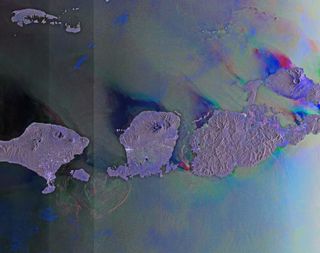
Indonesian Islands: Where Tectonic Plates Meet

The tropical islands of Bali, Lombok and Sumbawa tower above the waves in this image from the European Space Agency's Envisat satellite. All three islands are volcanoes, part of the Sunda Arc.
The island on the west, or left side of the picture, is Bali, one of Indonesia's main tourist destinations. The island's central mountains include peaks that reach 9,800 feet (3,000 meters), including an active volcano on the right side of the island. The central island is Lombok. To the east is Sumbawa island, dominated by mountainous terrain and home to Mount Tambora, an active volcano.
Mount Tambora's last major eruption was in 1815, killing more than 70,000 people and cooling much of the Northern Hemisphere, causing "the year without a summer." The eruption is one of the biggest and deadliest in recorded history.
All three islands sit over the submarine Java trench, where one tectonic plate slides under another. As the plate descends into Earth's mantle, fluids from the crust move into the mantle rock, letting it melt more easily, and the melted rock rises upwards like lava lamp blobs. These lava blobs punch through the crust, forming volcanoes.
This image is a compilation of three passes by Envisat on June 20, Aug. 19 and Dec. 17, 2011. The colors reveal changes in the surface between Envisat's passes.
Sign up for the Live Science daily newsletter now
Get the world’s most fascinating discoveries delivered straight to your inbox.

